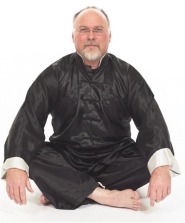
- Intention and Visualisation such as the “golden thread” – with head floating up, body weight sinking down.
- Balance exercises – such as a number which involve “spiralling” the body while co-ordinating the arms/legs with the central core movement of the dantien. Wherever possible these can be done with feet together and eyes closed.
- Holding of postures – such as the “standing pole” Chi Kung exercises and the relaxed maintaining of Tai Chi postures.
- Hands on corrections – which enable us to understand the difference between what we think we are doing and what we are actually doing – and so correct to a more vertical posture.
- Mindfulness – maintaining the awareness created in our practice.
- Relaxation – allows the body to straighten – where otherwise tensions might have pulled it out of shape.
- Opening of joints – by opening the vertebrae we can extend and straighten the back – opening other joints relaxes the way the weight is carried and distributed along the spine.
- Internal body awareness – by being sensitively aware we can be more mindful.
- Concept of Chi, Prana, energy etc. – enables us to compare the way we move and to develop strength and fluidity.
These additional principles take use of the back from slow standing movement through to vigorous activity by cultivating:
- Resilient skeletal muscular structure
- Moving from the centre
- Sequentially segmental body use
- Spiralling
Clearly the best approach is to initiate habits of good posture and movement before any problem presents, or failing that to catch a back problem before it becomes too severe or chronic. The principles of Tai Chi establish good habits of body usage from any point – and can offer a healing pathway if a situation of dis-comfort is caught early enough. Even when the spine fails to relax or straighten then practice can still lead to improved balance and mobility – in other words even if a back problem does not resolve then improvement in general body usage may significantly improve the overall situation.
It seems likely that best results would be achieved by sufferers working in conjunction with their medical practitioners and other therapists as well as using Tai Chi practice e.g. physiotherapy, osteopathy, acupuncture, Shiatsu etc.





